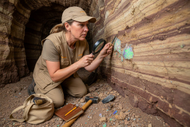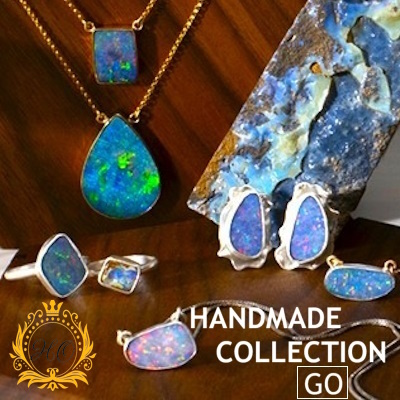What Is Opal Formation? Complete Geological Overview
Posted by AOD on 22nd Oct 2025
What Is Opal Formation? Complete Geological Overview
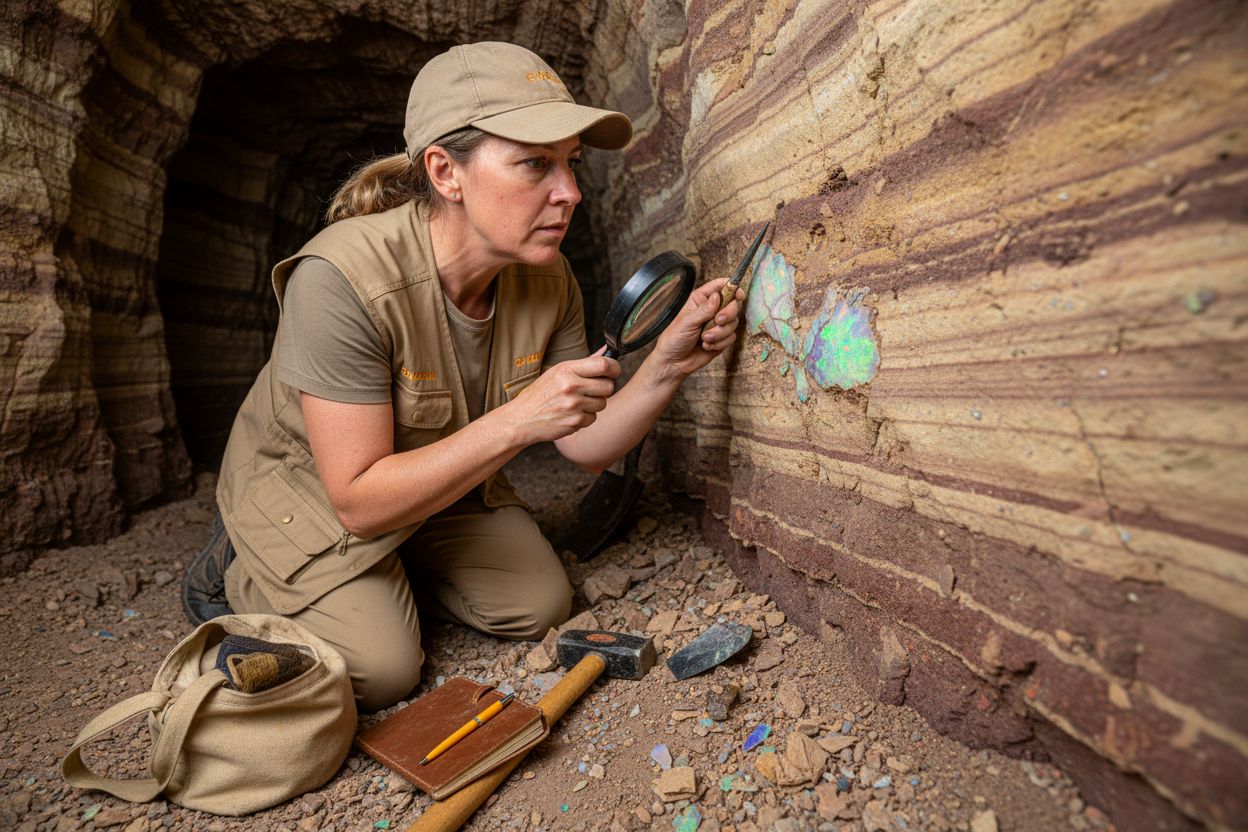
Did you know that some Australian opals are over 100 million years old? These captivating gemstones form when silica-rich water seeps through ancient rock layers, gradually building shimmering stones unlike any other. Their alluring play of color is not just beautiful, it tells the story of rare geological conditions coming together across eons. Understanding how opals take shape reveals why each one is as unique as a fingerprint, shaped by time and Earth’s secrets.
Table of Contents
- Defining Opal Formation And Its Geological Basis
- Types Of Opal Formations In Australia
- The Natural Process Behind Opal Creation
- Essential Conditions For Opal Formation
- Common Misconceptions About Opal Origins
Key Takeaways
| Point | Details |
|---|---|
| Opal Composition | Opals are hydrated, amorphous silica containing 6-10% water, distinguished by their unique play-of-color and complex geological origins. |
| Formation Process | Opals form over millions of years as silica-rich groundwater travels through rock, accumulating silica gel in impermeable layers, influenced by geological conditions. |
| Types of Opals | Australia features three main opal types: crystal, boulder, and matrix opals, each with unique characteristics stemming from their geological formation. |
| Misconceptions | Common myths about opals include oversimplified formation theories; actual opal creation involves complex long-term geological processes and specific geological conditions. |
Defining Opal Formation And Its Geological Basis
Opals represent a fascinating hydrated, amorphous form of silica with a unique geological origin that transforms ordinary minerals into extraordinary gemstones. According to the Australian Museum, opals contain 6-10% water and are distinctly different from crystalline minerals, creating their signature mesmerizing visual effects through intricate structural arrangements.
The formation process begins when silica-rich groundwater migrates through rock formations, carrying dissolved silica that gradually accumulates and hardens into silica gel. According to Geoscience Australia, this typically occurs in Cretaceous sandstones and mudstones where weathering releases silica, which then travels through geological faults and joints before becoming trapped by impermeable rock layers. These conditions create the perfect environment for opal development.
What makes opals truly remarkable is their play-of-color, a phenomenon caused by the precise arrangement of microscopic silica spheres. When light passes through these uniformly sized spheres, it diffracts and creates stunning rainbow-like displays. Smaller spheres tend to produce blue and green colors, while larger spheres generate red hues, making each opal a unique geological masterpiece. Learn more about opal’s fascinating history in our comprehensive guide on opal stones.
The diversity of opals reflects their complex geological origins. Different formations like crystal, boulder, and matrix opals emerge from variations in host rock relationships, transparency, and structural configurations. This geological complexity ensures that no two opals are ever exactly alike, transforming each stone into a natural work of art shaped by millions of years of geological processes.
Types Of Opal Formations In Australia
Australia is home to a remarkable diversity of opal formations, each representing unique geological processes that create stunning gemstones. According to the Australian Museum, three primary opal types dominate the landscape: crystal opal, boulder opal, and matrix opal, each with distinctive characteristics that make them prized by collectors and jewelers worldwide.
In the renowned Lightning Ridge region, seam and nobby opals emerge from ancient geological environments. White Cliffs produces white or crystal opals nestled within soft claystone seams, while the Queensland fields are famous for boulder opals - thin precious opal layers intricately embedded within ironstone matrices. Explore the fascinating details of different opal types in our comprehensive guide.
The Coober Pedy and Andamooka regions showcase extraordinary matrix opals, where vibrant opal deposits are diffused throughout sandstone or ironstone. These unique formations result from millions of years of geological transformations, with specific areas like Winton, Yowah, Quilpie, and Koroit each contributing their distinctive geological signatures to Australia’s opal landscape.
Here’s a comparison of the three main Australian opal types and their key geological features:
| Opal Type | Host Rock/Matrix | Typical Location(s) | Distinctive Features |
|---|---|---|---|
| Crystal Opal | Claystone Sandstone |
Lightning Ridge White Cliffs Coober Pedy |
Transparent Vivid play-of-color |
| Boulder Opal | Ironstone | Queensland (Winton, Yowah, Quilpie, Koroit) |
Thin opal seams Ironstone backing |
| Matrix Opal | Sandstone Ironstone |
Andamooka Queensland fields |
Opal diffused in host rock |
Each opal formation tells a geological story.
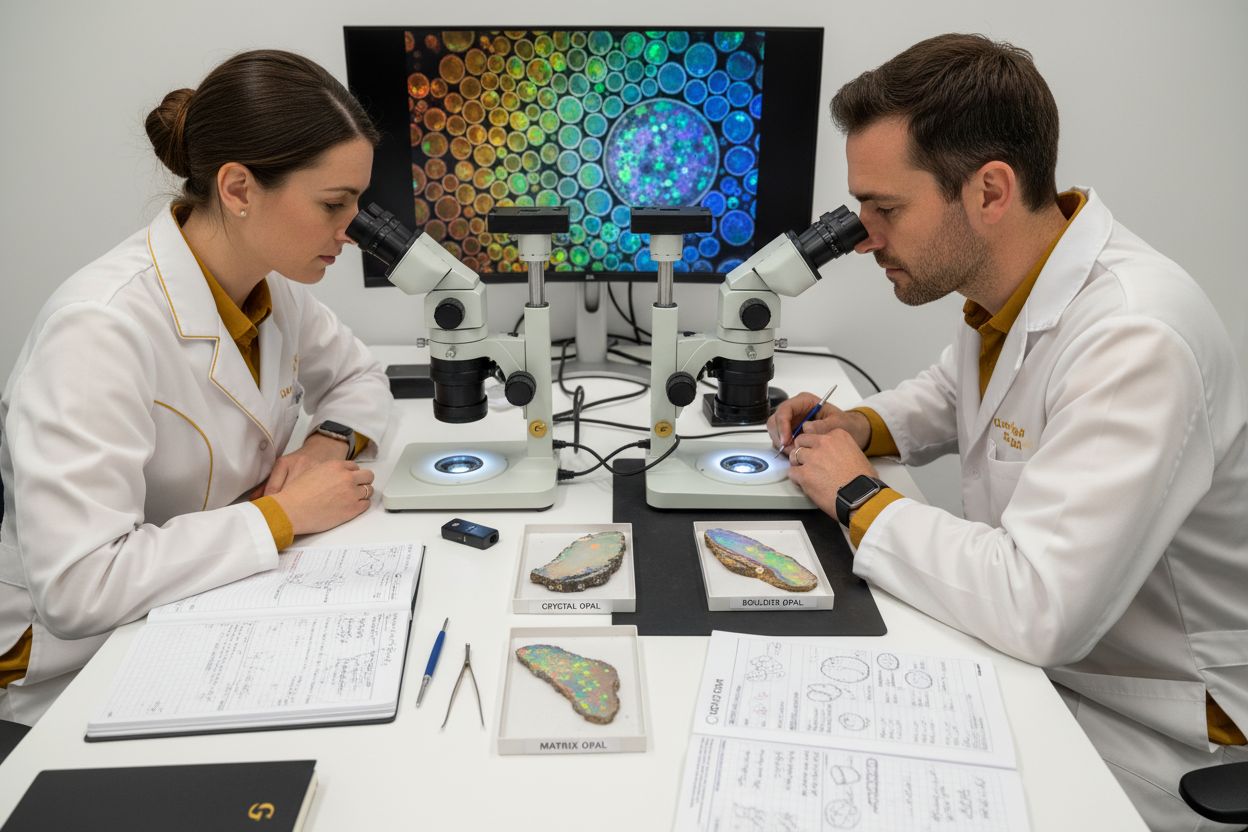 From the transparent crystal opals with internal color play to the rugged boulder opals embedded in iron-rich matrices, these gemstones represent more than just beautiful stones - they are physical records of Australia’s complex and ancient geological history, capturing millions of years of environmental processes in their mesmerizing structures.
From the transparent crystal opals with internal color play to the rugged boulder opals embedded in iron-rich matrices, these gemstones represent more than just beautiful stones - they are physical records of Australia’s complex and ancient geological history, capturing millions of years of environmental processes in their mesmerizing structures.
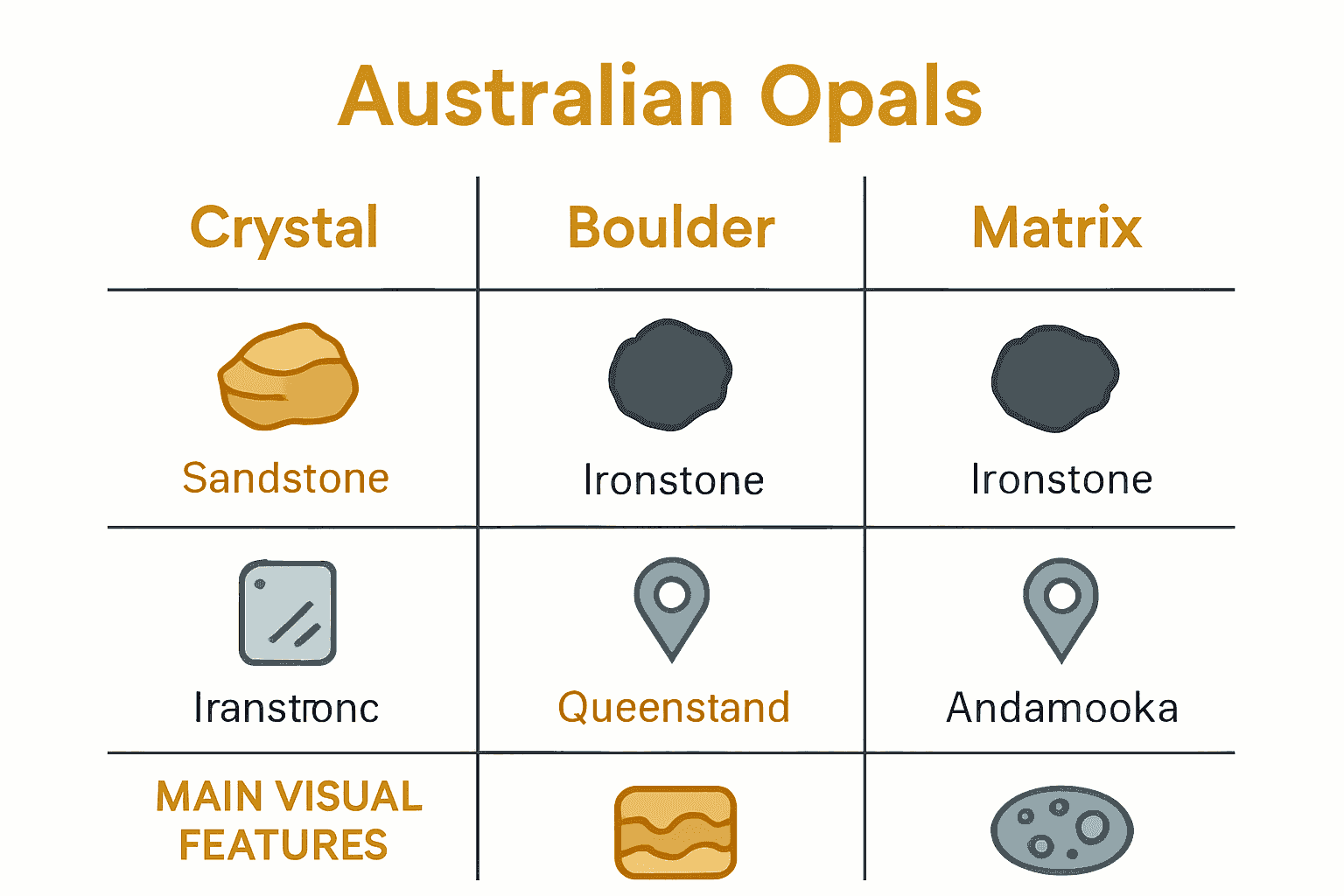
The Natural Process Behind Opal Creation
The formation of opals is a complex geological process that unfolds over millions of years, transforming ordinary minerals into extraordinary gemstones. According to Geoscience Australia, opal creation begins when silica is released from weathered sedimentary rocks and transported by groundwater into fractures and voids where it gradually gels and solidifies.
Recent research from the Australian Geographic reveals a fascinating chapter in opal formation, particularly in central Australia. Approximately 100-97 million years ago, an extraordinary episode of acidic weathering occurred during the retreat of inland seas. This unique environmental shift increased soil acidity, which released silica from sandstone. Learn more about the fascinating age and origins of opals in our comprehensive exploration.
The geological conditions play a crucial role in opal development. Gravity influences the intricate layering of silica spheres, creating the distinctive characteristics of each opal. The process involves precise environmental conditions: specific levels of acidity, precise mineral concentrations, and strategic geological locations where silica can accumulate and crystallize.
What makes this process truly remarkable is how seemingly random geological events converge to create these luminous gemstones. The delicate balance of temperature, mineral composition, and geological pressure transforms simple silica into vibrant, light-refracting stones that capture millions of years of Earth’s complex history within their mesmerizing structures.
Essential Conditions For Opal Formation
Opal formation demands an intricate combination of geological, geochemical, and hydrological conditions that rarely converge simultaneously. According to Geoscience Australia, the process begins with deeply weathered Cretaceous sedimentary rocks that liberate silica, creating the fundamental building blocks for these extraordinary gemstones.
The journey of opal creation requires specific pathways for silica-rich groundwater, typically utilizing geological fractures, faults, and joints that allow mineral-laden solutions to migrate. Gravity plays a crucial role in this process, influencing the sorting and layering of microscopic silica spheres. Discover more about the intricate process of identifying genuine opals in our comprehensive guide.
Research from the Australian Geographic highlights a remarkable geological window approximately 100-97 million years ago in central Australia. During this period, a unique combination of acidic weathering from retreating inland seas, followed by decreasing acidity during arid conditions, created the perfect environment for silica gel precipitation. These conditions are extraordinarily rare, making each opal a testament to an almost miraculous convergence of environmental factors.
The final critical condition involves the trapping mechanism - impermeable geological layers that contain and solidify the silica gel. This delicate process requires precise environmental conditions: specific mineral concentrations, strategic geological locations, and a slow, uninterrupted period of gel formation and hardening. The result is a gemstone that encapsulates millions of years of geological history within its luminescent structure.
Common Misconceptions About Opal Origins
Opals have been surrounded by numerous myths and misconceptions that distort our understanding of their remarkable geological formation. A widespread popular misconception suggests that opals simply form from rainwater leaving silica in rock crevices, but the actual process is far more complex and involves intricate long-term geological transformations.
Another fascinating myth revolves around the extraterrestrial origins of opals. While some believe opals were present on Mars, scientific research reveals that although opal-like minerals have been discovered, their formation processes differ significantly from terrestrial opals. Explore the fascinating details about opal origins in our comprehensive information guide.
Some persistent myths about opals relate to their physical properties and care. Contrary to popular belief, solid opals actually contain water internally and are not damaged by moisture. The gemstone’s stunning color display is an optical phenomenon independent of temperature, meaning body heat does not enhance its brilliance. In reality, opals maintain their lustrous appearance for years and only require occasional re-polishing to preserve their natural beauty.
The complexity of opal formation demonstrates how geological processes are far more nuanced than simple assumptions might suggest. Each opal represents a unique geological narrative, formed through millions of years of precise environmental conditions, making these gemstones not just beautiful adornments but true natural wonders that challenge our understanding of mineral creation.
Discover the True Beauty Behind Opal Formation and Own a Piece of Earth’s History
Understanding the complex geological wonders of opal formation reveals more than just a gemstone; it reveals millions of years of natural artistry and rare environmental conditions. If you are captivated by the intricate process of silica gel transforming into vibrant, mesmerizing opals, then connecting with authentic Australian opals is the next step to experiencing this geological masterpiece firsthand. Each opal carries the story of ancient weathering, mineral-rich waters, and unique geological settings like Lightning Ridge and Coober Pedy, making every stone a symbol of nature’s extraordinary patience and beauty.

Take your fascination beyond knowledge and into possession by exploring the ethically sourced, premium-quality opals available at Australian Opal Direct. Whether you seek the vivid play-of-color in a crystal opal or the rugged charm of boulder opals, our curated collections bring these geological marvels to you directly from Australia’s renowned fields. Don’t miss the chance to own an authentic gemstone that reflects the rare conditions described in the geological overview. Visit us today to choose your unique opal and enjoy benefits like free shipping, 90-day warranties, and custom design options to make your purchase truly personal.
Frequently Asked Questions
What is the formation process of opals?
Opals form when silica-rich groundwater moves through rock formations, where dissolved silica accumulates and hardens into silica gel over millions of years. This process involves precise environmental conditions like acidity and temperature.
What types of opals are commonly found in Australia?
The most common types of opals found in Australia are crystal opal, boulder opal, and matrix opal, each characterized by distinct geological features and formation processes.
How does the ‘play-of-color’ in opals occur?
The captivating ‘play-of-color’ in opals arises from the arrangement of microscopic silica spheres. When light passes through these spheres, it diffracts, producing a spectrum of colors based on the size of the spheres.
What are the essential conditions for opal formation?
Opal formation requires a unique combination of geological, geochemical, and hydrological conditions, including the liberation of silica from sedimentary rocks, the presence of groundwater pathways, and impermeable rock layers for gel solidification.
